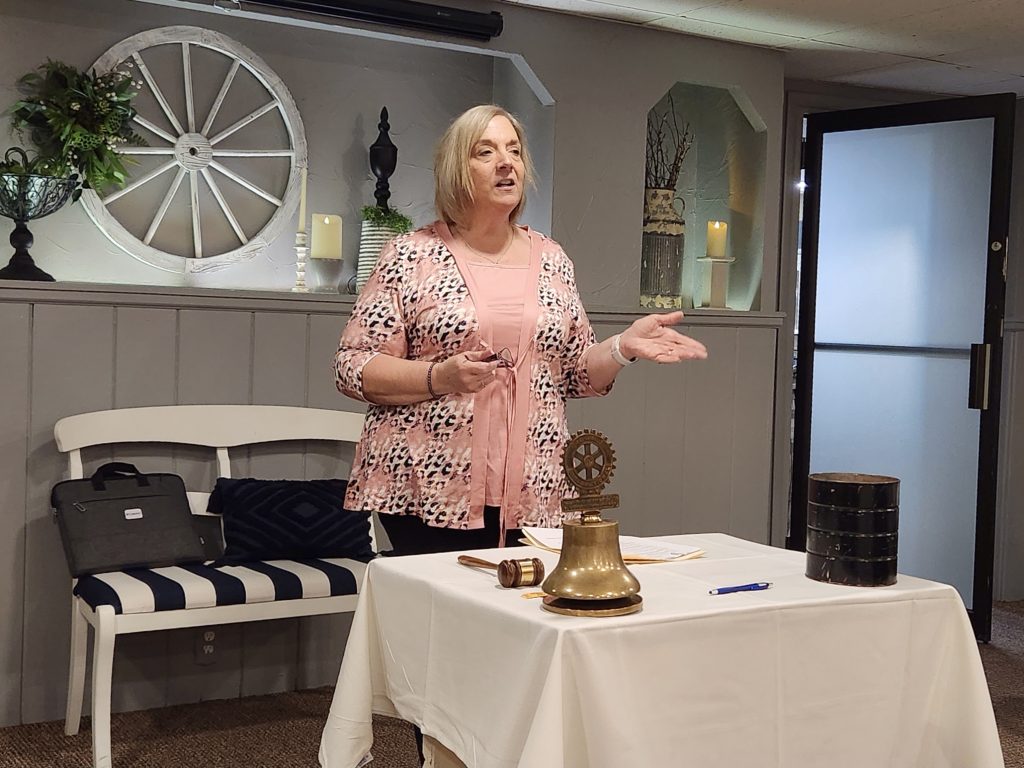Clinton County Central Dispatch says, more than anything, Citizens in distress need to know …. “Where is your emergency?”. Not only will that be the first question asked if you call 911, but your location is also not always available from your phone call. “Many people do not know where they are,” said Renee Crick, Director of Clinton County Central Dispatch. Dispatch struggles with this problem daily. Crick spoke at the Frankfort Rotary Club Thursday and gave an update on Central dispatch that serves all of Clinton County.
Before 2008, emergency calls went separately to Police or Fire or EMS (Emergency Medical Services). This triple layer delayed and complicated response when seconds matter. “Please hold on, I’ll transfer your call” is now a thing of the past. In 2009, Central Dispatch combined all three services and was placed in the secure basement of the Clinton County Sherriff Department building at 301 East Walnut Street. “It is a building within a building,” said Crick.
Crick started handling emergency calls for the Frankfort Police Department in 1990. By 2010 she became director Central Dispatch in the new location. Central dispatch is transitioning from 12 responders to 16. This will enable Dispatch to have more redundancy and capacity when needed. Last year Central Dispatch completed:
- 34,173 calls for service (police/fire/EMS)
- 47,732 total calls, including administrative and non-emergency calls
- 14,600 911 emergency calls
Working in dispatch can be a real pressure cooker position that requires the right temperament. A dispatcher must be comfortable with medical emergencies, life and death situations, trapped people, suicide attempts or non-stop calls during weather emergencies such as tornados, blizzards and high wind events. Situational awareness is key as downed powerline locations emerge, life support vehicles stationed throughout the county have to be relocated to provide back up and reduce response times as the ongoing picture rapidly changes.
Dispatchers in Clinton County now have access to “Power Phone” that pulls up certified responses to known symptoms on the field. The Dispatcher can enter “Chest pain” or other key words like “poison” into the system and immediately step by step questions and life-saving steps appear on the screen. Now the dispatcher can guide a family member or good Samaritan while help is on the way. CPR instructions are given out frequently. Dispatchers had to give out CPR instructions yesterday (March 13) and do so at least monthly.
Clinton County Dispatch will now accept Text-to-911 messaging. 70 text calls were made to Clinton County Dispatch last year and texting can go both ways if Dispatch wants to talk to the texter.
- Select “create a new text message.”
- Put 911 in the to: field.
- Put your emergency and your location in the message body.
- Do not attach or send pictures or videos.
- Keep your message short and do not use abbreviations.
- After you enter your text, press send.
- If text to 911 is not available in your area, you will receive a message instruction you to dial 911
- Continue your dialog with the 911 center and follow their instructions.
Locating the emergency is not as easy as it sounds. Many people think, in the days of Uber and cell phone location apps, that the emergency location is always known down to the exact location. This is not always the case. Sometimes people have location information turned off on their phone. Sometimes the Dispatcher screen needs to be refreshed to accommodate older phones or the system is just not registering the exact location. Central Dispatch services 10 miles of interstate on I-65. Most of the time, callers have no idea where they are beyond “Somewhere between Indianapolis and Lafayette”.
Dispatch also has access to a Language Line where all 911 calls can be patched into a translating service capable of translating help in virtually every language in the world. Dispatch also uses “Rapid SOS” which is a comprehensive situational awareness mapping solution for Dispatch and Emergency responders throughout the U.S. “Rapid SOS” is designed to extract as much location information as possible from phones, police units and law enforcement cameras on the scene using a “veil web” system. The system also involves video and voice communications systems on a broadband network. Dispatchers also know all the locations for AED devices in the county. Frankfort Rotary Club just increased the number of AED (Automated External Defibrillator) units in Clinton County by 40. All these AED unit locations are known by Central Dispatch.
“The Full Moon is a thing” said Crick, who has 34 years’ experience dispatching emergency calls in Clinton County. Many dispatchers will tell you things pick up during a full moon. Some studies show logged incidents can rise by up to 9% during a full moon. Depending on what study you read, it has been shown kidney stones, volcano eruptions (not in Indiana :>) and baby births might even increase during a full moon.
Clinton County now has four emergency Life Support Vehicle (ambulance) locations:
2 – IU Hospital complex
1 – Mulberry
1-North of 28 on 29 near Boylston
The emergency response system has come lightyears from the days of no radios, no cell phones, locator maps or on-scene cameras. Even so, Crick will tell you there is no substitute for knowing your location without delay so help can get to you immediately, even if the phone reception drops or the system can not read your cell phone location.

